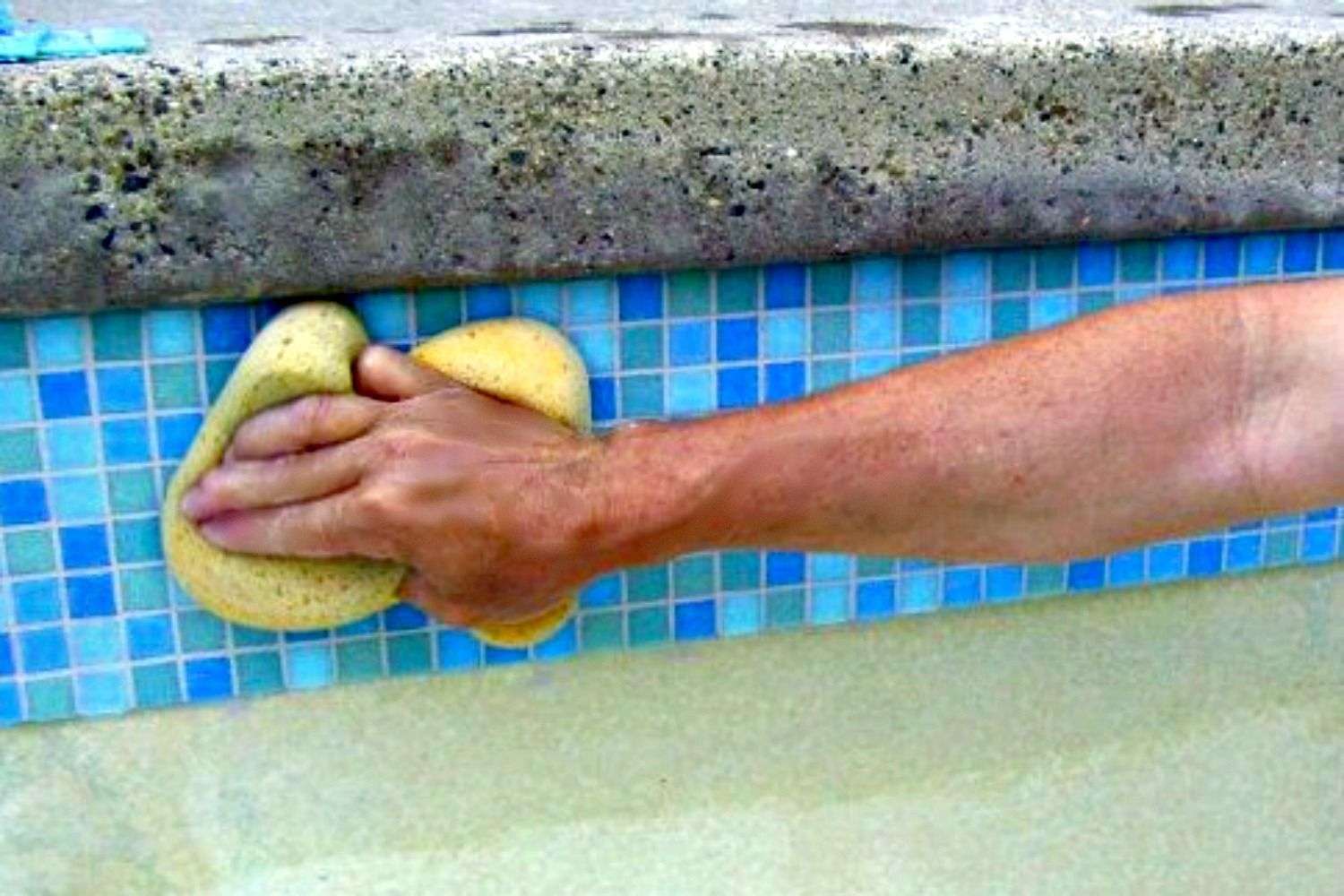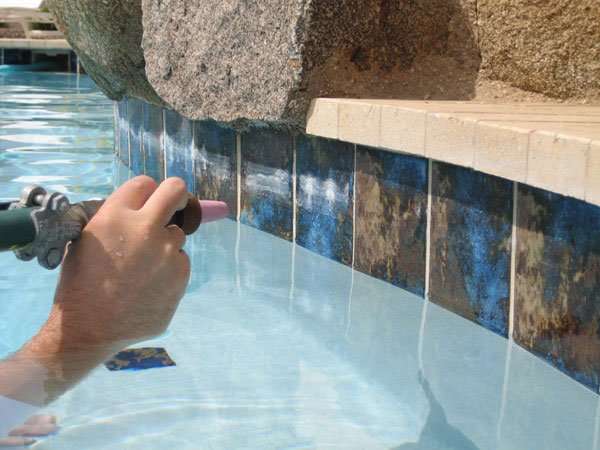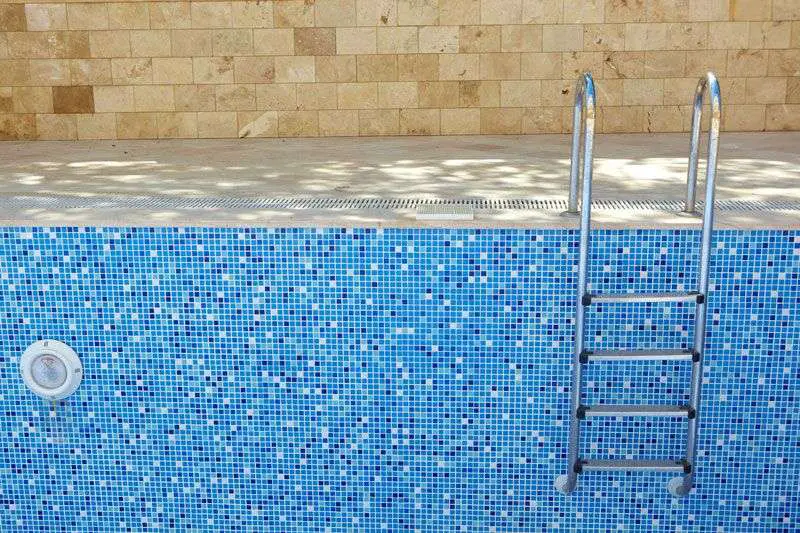How Often Should You Clean Your Pool Tiles
The pool must be maintained and taken care of regularly; if not, it may lead to various accidents, diseases, and infections. Maintaining the cleanliness of your pool is just one of the many ways of swimming pool care. It is recommended to have your pool cleaned at least once a week to keep it clean and uncontaminated.
What Is The Pool Waterline
The area near the top of the pool, just below the coping is considered the pool waterline. As the name indicates, it refers to the part of the pool wall where the water surface reaches. It is recommended to keep the water level of the swimming pool high enough to meet the waterline tile. However, the waterline tile is not the only factor to be considered when determining the optimal water level for instance, it is recommended that the water meets the middle of the pool skimmer hatch.
Follow Our Tips & Keep Pool Tiles Clean
If you find yourself lacking the time for the care of your pool, several pool maintenance companies in Australia are experienced and ready to give you a quote.
Follow these tips when you find yourself lacking the time for the care of your pool, as pool maintenance professionals in Australia are experienced and ready to help.
Read Also: What Chemicals To Use For Pool Start Up
How To Remove Calcium Deposits From Swimming Pool Tiles
Often you can notice white and chalky calcium on your swimming tiles pool surfaces. The calcium hardness is not dangerous, but its residue affects the pools appearance. Calcium hardness causes various buildup types of stains, heat, and hard water. Yet, the calcium buildup is most usual, and there are two forms available.
The first build is a calcium carbonate that leaves residue layers on swimming pool tiles. If you clean the pool tile quite often, you will remove calcium easily. You should use acidic solutions to take care of calcium carbonate if it builds up. Another type of calcium buildup is calcium silicate from the sand. It produces crystallized and sharp buildup, which is caused by calcium levels and high pH.
Calcium requires intensive cleaning methods, and when they build up, they cause filter failure. So, you should remove calcium from the pool tile carefully because muriatic acid can cause enormous damage. The muriatic acid will remove calcium while leaving tiles in flawless condition.
Cleaning the swimming pool tile at the waterline is quite a dirty process. This waterline pool tiles cleaning process is not tricky, but it is a pretty long process. Now, lets take a closer look at some steps for cleaning calcium deposits from a pool tile.
Take Advantage Of Hidden Storage Areas

Wolf notes that there are many neglected or overlooked areas that could be utilized for storage, but aren’t regardless of whether you’re living in a studio apartment or a 10,000-square foot luxury home. No matter how small your space, rethinking how you utilize it can unveil new storage opportunities.
“Many of the places we use every day could also double as storage be it the space on top of the kitchen cabinets, or even the floor under your bed or sofa. And you might be surprised to learn how strategic your furniture choices can be in helping you maximize storage. For example, ottomans and platform beds provide built-in storage drawers or cubbies where you can keep extra bedding, linens, towels and clothing. Closet storage shelving is the perfect home for rarely used items that can easily fit on top of your closet storage shelving. There’s almost always more space available, if you just think creatively.”
You May Like: How Do I Open My Pool
Option : Muriatic Acid
If vinegar or store-bought cleaning products dont work, the next step is to use a mixture of muriatic acid and water. You will find muriatic acid at your local pool store. Be sure to wear gloves and be careful when using the acid because it can cause burns and irritation if it comes in contact with your eyes or skin.
Pressure Washing Pool Tiles
If you are a DIY’er when it comes to in-ground pool maintenance, renting a pressure washer may be a good option for you. This is the best way to clean a pool tile that is safe and chemical-free.
You need no detergents for pressure washing. Pressurised steam set at 2000 to 2600 PSI can remove built-up dirt, mould, and calcium deposits.
You May Like: How To Deter Wasps From Pool
What Is That Stuff Anyway
The dirty stuff that discolors a pools water line is usually either scale or stain. If you have;hard-water deposits;or stains in sinks or tubs inside your house, they might be on your pool surfaces too. After water evaporates, scaling can occur when calcium deposits cling to the sides of a pool. It shows up as white or gray scum and is difficult to remove. The two main types of scaling in a pool are:
Pool staining can show up in a variety of colors and occurs as the result of a chemical imbalance reacting with the pools surfaces.
What Is Calcium Carbonate
Calcium carbonate is also a type of scaling that is caused by an imbalance in pH levels. This type of scaling is much easier to remove than calcium silicate and looks a bit different as well. When calcium carbonate builds up along your pools waterline, it is going to look flaky.;
When you touch it, it will either peel off in small sections or will flake off from very little friction. It is also a brighter white than calcium carbonate and is very rarely gray. Of course, this appearance will make it highly distinguishable, so you likely will not have to run the same type of tests, but it is encouraged to be sure that this is what you are dealing with.
If you cannot tell by appearance if the residue at the waterline of your pool is calcium carbonate, you can use the same method as suggested with calcium silicate. Simply place a few drops of muriatic acid along the waterline of your pool and wait for a reaction. If the residue begins to bubble and foam, it is calcium carbonate. Lucky for you, this means a much easier removal with significantly less time cleaning the waterline up.;
Don’t Miss: Are Pool Fences Required In Arizona
Taking It A Step Further With Mosaic Art
Not one for mass-produced designs? If you are looking for something unique to make your pool stand out and dazzle everyone a custom made glass mosaic pool waterline is the perfect solution. Decorative glass mosaic waterline tile can upgrade the style quotient of your space. Light, glass and water make for a spectacular trio. Glass captures and reflects natural light so beautifully. When the light passes through the water and hits the mosaic tiles it creates a visual wonder like a thousand little gems glistening.
Why You Need To Remove Calcium From Pool Tile
Sure, no one wants to swim in a crusty-looking pool. It just feels gross and icky. If that was the end of the problems that calcium deposits caused, it wouldnt be such a big deal. You could probably suffer through the summer, for example, and then have them cleaned off when youre not going to use the pool quite so much.
Unfortunately, that isnt wise.
Why?
Because calcium scale also does damage to your pool and pool equipment. That damage will only get worse until you have it removed.
Without pool tile cleaning, what can calcium deposits do to your pool?
You May Like: When Do Pools Open In Virginia 2020
As Far As Possible: Sharp Objects And Toys
Now, this tip might not seem related to your pools cleanliness, but it in fact has a lot to do with your pools safety and hygiene. Sharp objects and toys that are unsuitable for the pool environment could either tear your liner or alternatively, introduce new bacteria to your pool water. The tears of the liner could accumulate unwanted algae and other debris. Eventually, harming your pools cleanliness.
How To Remove Black Stains From A Pool’s Water Line

21 September, 2017
If you have an unsightly black ring around the waterline of your pool, this is known as “scale.” Scale forms from a mixture of mineral deposits, body oil, dirt, scum and other debris. Removing scale with conventional cleaners is very difficult, but there are a few products available, like First Aid, Power Blue, Off the Wall and Jack’s Magic Blue Stuff, that are specially formulated to remove scale from tile and waterlines. Despite these products’ effectiveness, removing scale is time consuming and requires a lot of elbow grease.
You May Like: How Much Are Pools In Las Vegas
Get Serious With Serious Tools
If these basic tools wont work, try a pumice stone.;A pumice stone made of ground volcanic rock will chip away as you scrub with it. Make sure you wet the stone and keep it wet as you scrub or you may scratch your tile.;
Work with a light touch. Scrub the gunk in a circular motion along the waterline.;
Then look into using a tile cleaner containing sulfamic acid. CLR and Lime-Away are the most common cleaners youll find in regular department stores. These contain harsh chemicals, so use them with extreme care.;
If youve used pool chemicals recently, wait on the sulfamic acid.;Once you clean your tile, wait a few days before you add chemicals or swim in the water.;
When To Clean Pool Tile
Always plan on cleaning the tiles at the beginning and end of your pool season.;
Then, as soon as you notice the tile at the waterline has discoloration, clean it. Then put yourself on a cleaning schedule be it monthly or weekly. Plan on cleaning regularly to avoid letting the stains build up more over time.;
Recommended Reading: How Do You Build An Inground Swimming Pool
How Much Does It Cost To Clean Pool Tile
Average cost of pool tile cleaning service is between $700 to $1,200 and in some cases more depending on the size of pool and total square footage of tile to be cleaned. By doing this you can enjoy the pool much more as it will appear to look fresh and new again.
Be Thorough: Reach The Unreachable
Its true that this guide is all about easy and simple tips, but every now and then, you just have to get in there and give that pool a thorough scrub. People tend to forget that some pool areas are neglected in your day-to-day pool routine. Dirt and other bacteria can form around swimming pool ladders, stairs and pool surface corners. You could either do a thorough clean once a year or have a professional over.
Recommended Reading: When Do Pools Open Up
The Systematic Dolphin M 400
The Dolphin M 400 is a model built for residential pools under 15m, for ultimate cleaning and an ideal pool scrubbing experience. The cleaner is highly efficient in scrubbing the pool surface, which is especially important if youve only recently cleaned your pool from bacteria and algae. This model can also successfully tackle different types and sizes of debris.
Clean Pool Tile Can Extend Your Pools Lifespan
Your pool is a safe place to get away from the heat during the hot summer days, so make it the best it can be.;
Clean pool tile isnt just about having a beautiful pool, though. Its also about keeping scale from building up in the pools pump system.
The pool tile should be cleaned a minimum of three times per pool season. The ways to clean pool tile we listed above may seem easy to do if you are handy; however, it is a delicate process not to damage and discolor the tiles. It also can be a timely project. If this is the case with you, consider bringing in a professional to help.;
The team at Backyard Pool Specialists knows all the pool tile cleaning tricks. If you live in the Houston area and surrounding areas of Cypress, Spring, Conroe, Montgomery, The Woodlands, Katy, Tomball, and Magnolia,;contact us;about pool tile cleaning. We offer customers a free price quote on our services.;
BPS is a family-owned business that has been making swimming pool dreams a reality since 1978. Throughout the years, we have expanded our company to include every facet of services for backyards and swimming pools in Houston, Texas.
Don’t Miss: Where Is Doheny Pool Supply Located
Thin White Calcium Film On Tiles
When tiles get wet, the water evaporates which leaves any calcium and minerals in the water to solidify on the tiles. This picture shows what calcium looks like on waterline tiles. This type of calcium formation is unavoidable as it is a simple function of chemistry.; This occurs because the calcium in your water needs to go somewhere after the water evaporates. Calcium chloride is always present in balanced water and this calcium will become visible on most surfaces after evaporation occurs, particularly if your calcium hardness level is high.; This type of calcium formation will almost always happen on waterline tiles due to heat, wind and fast evaporation, particularly in summer.; If the pH of your water is consistently high, this will accelerate the formation of calcium on your pool tiles.
Waterline Problems: Stains And Scale

The pools water line problems are either stains or scale.
If you notice stains or deposits caused by hard water in the bath tubs and kitchen sinks in your house, you are likely to also notice those same stains on the surface of the pool. When water evaporates, the calcium deposits remain on the sides of the pool and cause scale. It appears like difficult to remove gray or white scum. You will notice two types of pool scaling:
Pool staining can vary in color because of an imbalance in the chemical composition of the pool water.
Read Also: Who Installs Above Ground Pools
Ending Thoughts On How To Remove Calcium Deposits From Swimming Pool Tiles
Cleaning calcium deposits from swimming pools is an easy process. A pool tile maintenance routine is also essential when cleaning pool water deposits. It will not only prolong the durability of the tiles but will also reduce maintenance costs. You will not have to replace tile pieces very often in the future. Ensure you take care of your swimming pool regularly, so you do not have to worry about any calcium hardness.
If you enjoyed reading this article on how to remove calcium deposits from swimming pool tiles, you should read these as well:
Household Chemicals & Cleaners
For basic cleaning mix equal parts vinegar and water and spray it on the area you want to clean. Leave it there for a while then clean it off with a soft cloth to get rid of light staining and calcium carbonate casts. Rinse it off and let it dry. For stained grout you can use the same mixture with warm water and clean with a soft bristled brush or toothbrush. Good quality swimming pool cleaning brushes and non abrasive scouring pads work best.
Tougher grout stains can be tackled by applying a baking soda and water paste to the grout before the vinegar spray step. Be sure not to scrub too harshly, that might wear off cementitious grout. To minimize grout staining and wearing off, you can seal it periodically or use epoxy grout.
There are some specialized commercially available glass tile cleaning products like, Limesol, that you can try. Additionally, you can also use mild cleaning products already available at home like even a dish detergent or even toothpaste.
Don’t Miss: What Is An Infinity Pool
What Is Building Up On Your Waterline Tiles
Waterline tiles are often subjected to scale or stains building up on the surface. Staining can occur due to a chemical imbalance or as a result of organic material such as leaves and soil clinging on to the surface for an extended period of time.
When the pool water naturally evaporates, calcium deposits can attach to the sides. This calcium scaling will appear as a white-gray colored scum and can be problematic to remove. Generally speaking, there are two types of scaling you may find on your waterline pool tiles:
